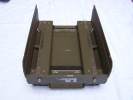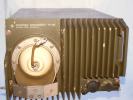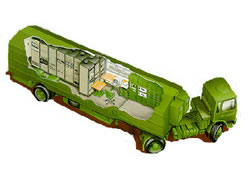|
XK 405
The HF radio set XK 405 is a mobile radio, built by Rohde & Schwarz ©.
It was mostly used in tanks.
It consists of:
Operational unit
 |
Operational unit |
All operational elements, as well as the display, are on the front side.
The connectors for handset, loudspeaker and transceiver also are on the front.
Transceiver
 |
Transceiver |
It contains all modules needed for operation. During operation it is cooled by a fan.
A 23-connector-cable connects the operational unit to the transceiver.
All connectors needed for operation are situated on the front plate.
The modes can be speech, CW, (and with external modem also AFSK).
The operational unit can be used up to a distance of 90 m.
A test device is built in.
The transmitter part is verified continuously, and the result
is displayd continuously. A test without transmitting also is possible.
While receiving, the test is audible by a pulse-sequence; no RF is transmitted.
If switched to SEND/EMPF the complete signal way is tested with RF- transmission,
and the result is shown by showing the numbers 1 to 9 on the display of
the operational unit.
The REMUS- connector ***
is on the underside of the transceiver. Two quick release screws hold the transceiver to the
shock absorbing mounting.
Shock absorbing mounting
 |
Shock absorbing mounting |
It protects the radio from mechanical shocks, and guides the cooling air.
Antenna matching unit (ATU)
 |
Antenna matching unit
(ATU) |
A transmitter has a real resistance of 50 Ohm. An antenna has a radiation resistance,
depending on the kind of antenna and frequency used. So this antenna resistance keeps
changing with the frequency.
The task of an ATU is to transform the real resistance of the radio to the radiation
resistance.
While transmitting, the values are preselected and stored; these values also stay the
same while receiving.
Below a frequency of 1.5 MHz the ATU is bridged over.
Accessories: Loudspeaker and handset.
 |
*** REMUS:
Rechnergesteuerertes
Einheitliches
Meß-
Und Prüf-
System
|
(Computer supported consistent measuring and checking system).
REMUS formerly consisted of 75 mobile testing systems, for abt. 1 million Euro per system.
The system could test 130 different modules of 20 weapon systems, and find out faults by comparing
the sub- modules. The complete periphery of the module was simulated by REMUS.
The system REMUS was suspended in 2002. Today only 7 systems are left; they still test radios of the
SEM 70/80/90 family.
- Frequency range:
- Transmit 1.5 ... 29.999 MHz
- Receive 10 kHz ... 29.999 MHz

Technical data:
- RF output:
- 400W or 60 W, protected against open or short output.
- Modes:
- A3J, A3H, A1, AFSK
- Operational voltage:
- 19 .. 31V; automatic switch off at < 19 and > 31V
- Power consumption:
- Transmit 60A at 24v (measured)
- Receive 3A
- Antennas:
- Rod or whip antennas 1.6 .. 12m length
- Dipole antennas by using a 50Ohm- adapter
- Length of the dipole antennas:
- 1.5 .. 2 MHz 30m, 2 ... 5 MHz 15m, 5 .. 15 MHz 5m
- Introduced: ??
- ( The TM dates from 1981 )
|